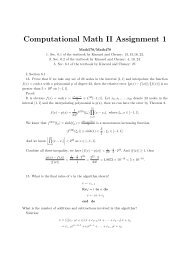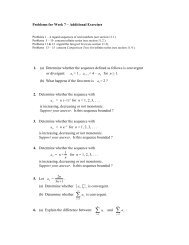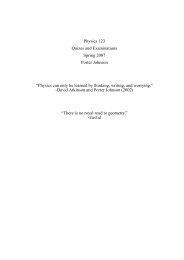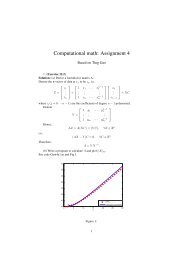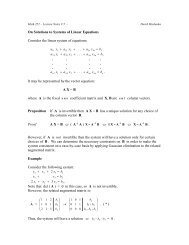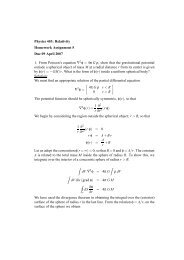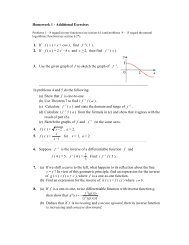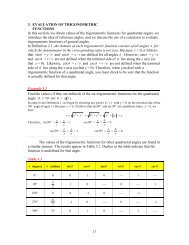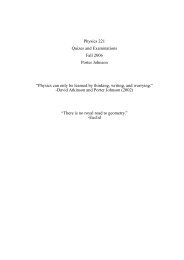Problems for Week 1 - Additional Exercises 1. If f ( x ) = x + cos x, find ...
Problems for Week 1 - Additional Exercises 1. If f ( x ) = x + cos x, find ...
Problems for Week 1 - Additional Exercises 1. If f ( x ) = x + cos x, find ...
You also want an ePaper? Increase the reach of your titles
YUMPU automatically turns print PDFs into web optimized ePapers that Google loves.
<strong>Problems</strong> <strong>for</strong> <strong>Week</strong> 1 - <strong>Additional</strong> <strong>Exercises</strong><strong>Problems</strong> 1 – 8 regard inverse functions (see section 6.1)<strong>Problems</strong> 9 – 15 regard the natural logarithmic function (see section 6.2*).<strong>Problems</strong> 16 – 21 regard the natural exponential function (see section 6.3*)<strong>Problems</strong> 22 – 34 regard general exponential functions (see section 6.4*).−1<strong>1.</strong> <strong>If</strong> f ( x ) = x + <strong>cos</strong> x, <strong>find</strong> f ( 1 ).2. <strong>If</strong> f ( x ) = 2 x 2 − 8 x and x > 2, then <strong>find</strong>−1f ( x ).3. Use the given graph of f to sketch the graph of−1f .___________________________________________________________In problems 4 and 5 do the following:(a) Show that f is one-to-one.(b) Use Theorem 7 to <strong>find</strong> ( f −1 )′( a ).−1−1(c) Calculate f ( x ) and state the domain and range of f .(d) Calculate ( f−1 )′( a ) from the <strong>for</strong>mula in (c) and show that it agrees with theresult of part (b).−1(e) Sketch the graphs of f and f on the same axes.4. f ( x ) = x − 2 , a = 2.15. f ( x ) = <strong>for</strong> x > 1, a = 2.x −1____________________________________________________________________________________________________________________________________________________________________________6. Suppose−1f is the inverse of a differentiable function f and2f ( 4 ) = 5, f ′ ( 4 ) = . Find (−f 1 ) ′ ( 5 ).37. (a) <strong>If</strong> we shift a curve to the left, what happens to its reflection about the liney = x ? In view of this geometric principle, <strong>find</strong> an expression <strong>for</strong> the inverseof g ( x ) = f ( x + c ), where f is a one-to-one function.(b) Find an expression <strong>for</strong> the inverse of h ( x ) = f ( cx ) where c ≠ 0 .8. (a) <strong>If</strong> f is a one-to-one, twice differentiable function with inverse function g,f ′′(g(x))then show that g′ ( x)= − .3[ f ′(g(x))](b) Deduce that if f is increasing and concave upward, then its inverse function
is increasing and concave downward.2⎛ r9. Use the Laws of Logarithms to expand ⎟ ⎞ln ⎜.⎝ 3 s ⎠2 210. Use the Laws of Logarithms to expand ln a ( b + c ) .__________________________________________________________In problems 11 and 12 do the following:Make a rough sketch of the graph of each function. Do not use a calculator. Just usethe graph of y = ln x shown in the figure and, if necessary, the trans<strong>for</strong>mations ofSection <strong>1.</strong>3.1<strong>1.</strong> y = ln | x |12. y = ln ( x + 3 )_______________________________________________________________________________________________________________________________________________________________________________13. Differentiate f and <strong>find</strong> the domain of f if f ( x ) = ln ( ln ( ln ( x )) ) .14. <strong>If</strong> g is the inverse of f ( x ) = 2x + ln x, <strong>find</strong> g′ (2).ln(1 + x)15. Use the definition of the derivative to prove that lim = <strong>1.</strong>x→0 x16. (a) Simplify1⎜ .⎝ eln15⎛ ⎞e (b) Simplify ln ⎟⎠x17. (a) Simplify ln( e sin ) (b) Simplify( x ln x)e + .x18. Make a rough sketch of the graph of the function: y = e − .xDo not use a calculator. Just use the graph of y = e shown inthe figure and, if necessary, the trans<strong>for</strong>mations of Section <strong>1.</strong>3in the Stewart textbook.19. Find the inverse function:2y = (ln x) , x > <strong>1.</strong>
20. Find the inverse function:2<strong>1.</strong> Differentiatey = e( ex).yxe= .x1+2ex22. (a) Write an equation that defines a when a is a positive number and x is areal number.(b)xWhat is the domain of the function f ( x ) = a .(c) <strong>If</strong> a ≠ 1, what is the range of this function?(d) Sketch the general shape of the graph of the exponential function<strong>for</strong> each of the following cases.(i) a > 1 (ii) a = 1 (iii) 0 < a < <strong>1.</strong>23. Write the expression as a power of e:2( )10 x .24. Write the expression as a power of e:x(<strong>cos</strong> x) .25. Find the limit:limt → + ∞(22 t− ) .26. Differentiatey=(5−1x).27. Differentiateytanθ= 10.28. Differentiate f ( u ) =( 2u 10+ 2−u ) .29. Differentiatey =232 x.30. Differentiatey=xx.3<strong>1.</strong> Find an equation of the tangent line to the curvexy = 10 at the point ( 1 , 10 ) .32. Evaluate the integral: ∫ 21t10 dt .33. Evaluate the integral: x 2 x 2 dx .y x34. Find y ’ if x y∫= .



